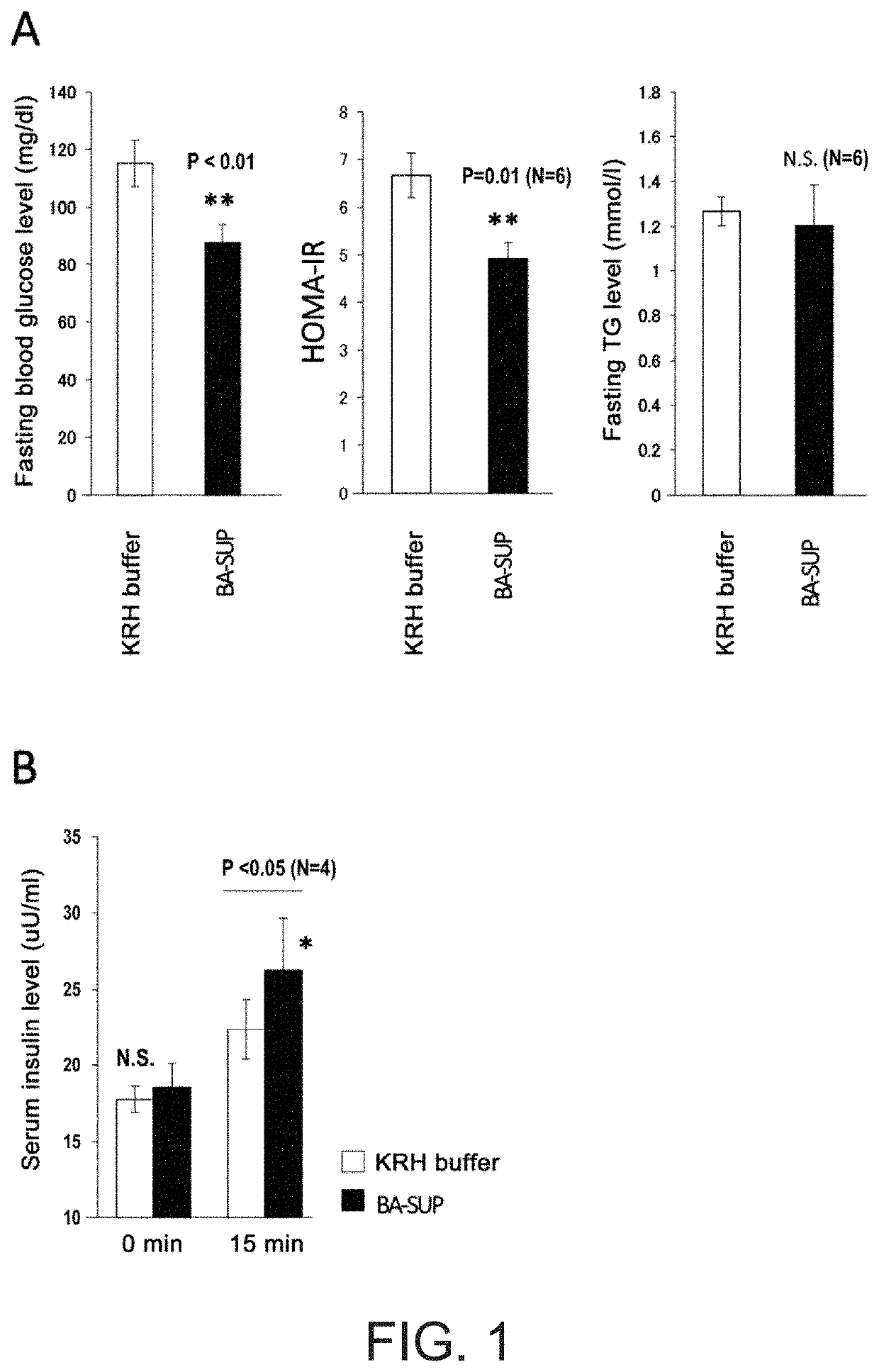Supernatant of brown adipocytes, method for preparing same and utilization thereof
a technology of brown adipocytes and supernatant, which is applied in the direction of skeletal/connective tissue cells, drug compositions, metabolic disorders, etc., can solve the problems of increasing the risk of developing life-threatening group of diseases, increasing the risk of death of people who have experienced obesity or overweightness in the past, and promoting insulin secretion. , to achieve the effect of enhancing insulin sensitivity, promoting insulin secretion, and inducing ba
- Summary
- Abstract
- Description
- Claims
- Application Information
AI Technical Summary
Benefits of technology
Problems solved by technology
Method used
Image
Examples
example 1
[Example 1] the Blood Glucose-Reducing Action when a Human ESC-Derived Brown Adipocyte Supernatant Prepared with “a Buffer Comprising Only Salts and a High-Concentration of Glucose” was Subcutaneously Administered to Mice
[0247]Differentiation into brown adipocytes (BA) was induced by the method described in [Reference Example 4] using a human ESC KhES-3 strain (Suemori et al., Biochem Biophys Res Commun 345: 926-932, 2006) maintained and cultured on mouse fetal fibroblasts (MEF). The differentiation medium was removed from mature BA on the 10th day of induction of differentiation (2nd day of adhesion culture in a culture dish with a radius of 6 cm after floating for 8 days), 2 ml of Krebs-Ringer-HEPES (KRH) buffer comprising 16.8 mM glucose (NaCl: 128 mM, KCl: 5 mM, CaCl2 2.7 mM, MgSO4 1.2 mM, Na2HPO4: 1 mM, HEPES (pH 7.4):20 mM, Glucose: 16.8 mM) was added thereto, this was cultured for 16 hours in a carbon dioxide incubator (at 37° C., 5% CO2), and the supernatant was collected (B...
example 2
[Example 2] the Glucose Transporter Gene Glut4 / GLUT4 Expression-Inducing Action of Human ESC-Derived BA Supernatant Prepared with “a BA Differentiation Medium” when Added to Skeletal Muscle Cells
[0250]Using human ESC (KhES-3 strain) maintained and cultured on mouse fetal fibroblasts (MEF), BA was prepared by the method described in [Reference Example 4]. Then, the differentiation medium was removed from mature BA on Day 10 and a fresh differentiation medium was added (medium exchange). After culturing in a carbon dioxide incubator (37° C., 5% CO2) for 16 hours, the supernatant was recovered (BA-SUP). As a control, a fresh differentiation medium was cultured in the carbon dioxide incubator (37° C., 5% CO2) using a gelatin-coated dish, and the supernatant recovered after 16 hours was used as a control supernatant (Control SUP).
[0251]Using mouse myoblast cell line C2C12 obtained from the American Type Culture Collection (ATCC), myotube cells were prepared on a 96-well plate according t...
example 3
[Example 3] the Insulin Secretion-Promoting Action on Pancreatic Beta Cells of a Supernatant of Human ESC / iPSC-Derived BA Prepared with “a Buffer Comprising Only Salts and a High-Concentration of Glucose”
[0255]SUP of human ESC-derived BA was prepared in the same manner as in [Example 1]. That is. BA was induced to differentiate from human ESC maintained and cultured on MEF (NPL 19), the differentiation medium was removed from the mature BA on Day 10, and then a KRH buffer comprising 16.8 mM glucose was added. The supernatant was collected after culturing in a carbon dioxide incubator (37° C., 5% CO2) for 16 hours. Meanwhile, MIN6 cells, which is a mouse pancreatic beta cell line (distributed by Jun-ichi Miyazaki, adjunct professor at the Office for University-Industry Collaboration, Osaka University (at present)), was cultured in a 96-well plate using the recommended method (Miyazaki et al., Endocrinology 127: 126-132, 1990). After washing with PBS buffer, this was cultured for one ...
PUM
 Login to View More
Login to View More Abstract
Description
Claims
Application Information
 Login to View More
Login to View More - R&D
- Intellectual Property
- Life Sciences
- Materials
- Tech Scout
- Unparalleled Data Quality
- Higher Quality Content
- 60% Fewer Hallucinations
Browse by: Latest US Patents, China's latest patents, Technical Efficacy Thesaurus, Application Domain, Technology Topic, Popular Technical Reports.
© 2025 PatSnap. All rights reserved.Legal|Privacy policy|Modern Slavery Act Transparency Statement|Sitemap|About US| Contact US: help@patsnap.com



